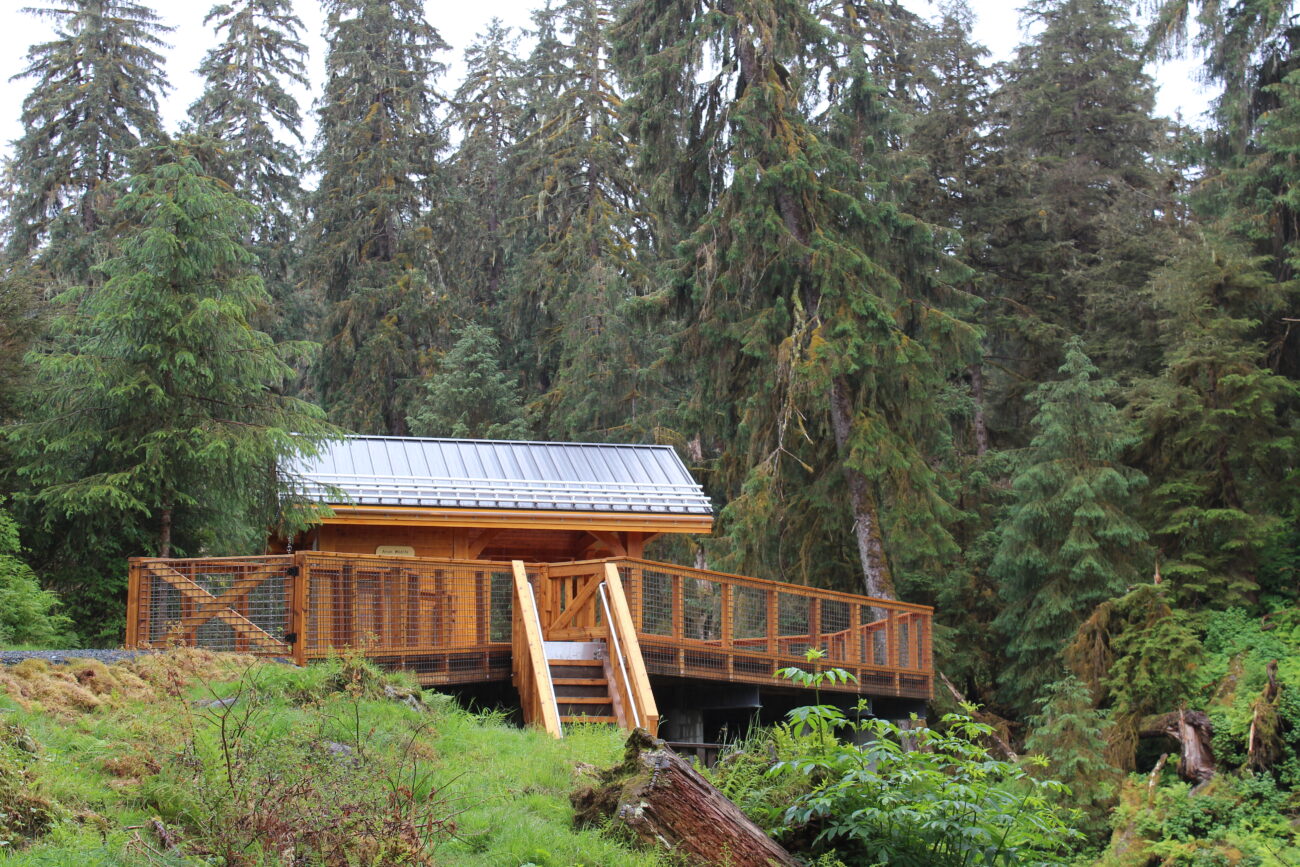
The U.S. Forest Service is ready to unveil a brand new viewing deck at the Anan Wildlife Observatory, a popular bear-watching site south of Wrangell. But a nearly-overflowing toilet might stymie the first days of the viewing season.
Over the last four or five years, the facilities at the Anan Wildlife Observatory about 30 miles southeast of Wrangell have had a major makeover. The old, brown-painted, multi-level viewing deck at Anan Creek has been replaced with a single-level, stained red cedar deck with a covered area at the back.
“I think it’s astounding,” says Wrangell Ranger District Recreation Planner Tory Houser. She says Petersburg-based Rainforest Contracting, who built the new deck, worked with a local artisan to construct the braces and dovetail woodwork.
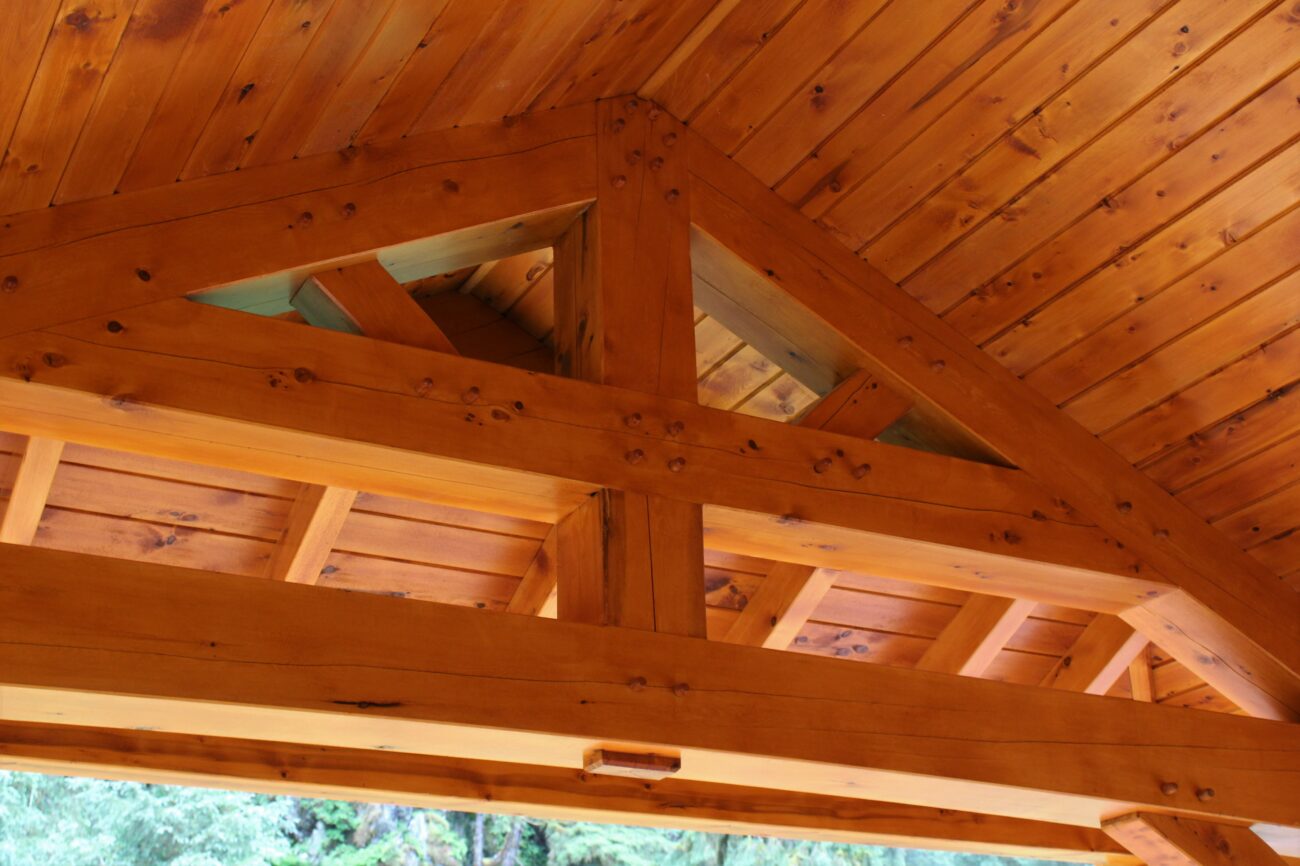
(Sage Smiley / KSTK)
“I really like that it has this sort of artistic feel, for being a recreation site on the forest,” Houser says, “And I love that we used trees from the Tongass National Forest to construct it, so we did use our local resources.”
The red cedar came from Icy Straits Lumber in Hoonah on Chichagof Island.
“We’ve done our final exams on this deck, and it is ready for business,” Houser said on a trip to the viewing deck on June 21, “And we are so excited to welcome all of our visitors this summer.”
Houser says the new deck has better viewing than the previous one that was built piecemeal beginning in 1964: “One piece was a helicopter landing. Another piece was a foundation for the fish ladder that goes underneath, and another piece was like actual viewing and a shelter, so the shelter was at the front of the deck, and it blocked a lot of the viewing.”
She says the outfitter guides that bring visitors to Anan were integral in the design process for the new deck.
“They actually drew out a design, which is what we used, and they said, ‘Let’s move that shelter back out of the way.’ So that’s how we get the shelter moved back,” Houser demonstrated, walking to the edge of the new deck: “You are now eight feet closer to the creek and over this water, and we are now about 18 inches higher than we were previously. Another thing that’s changed is that this deck is all one level. And the purpose of it was to maintain about the same footprint. In fact, I think we’re more condensed, but we have a lot more usable room.”
The deck replacement process started in 2017 during maintenance to the former upper deck outhouse.
“Our contractor went underneath the old deck and said, ‘Whoa, you know what, this thing is getting old. And there are some problems,’” Houser explains, “So we had to re-stabilize some of the old deck. But we said at that point, ‘We really need to be thinking about getting a new deck.’”
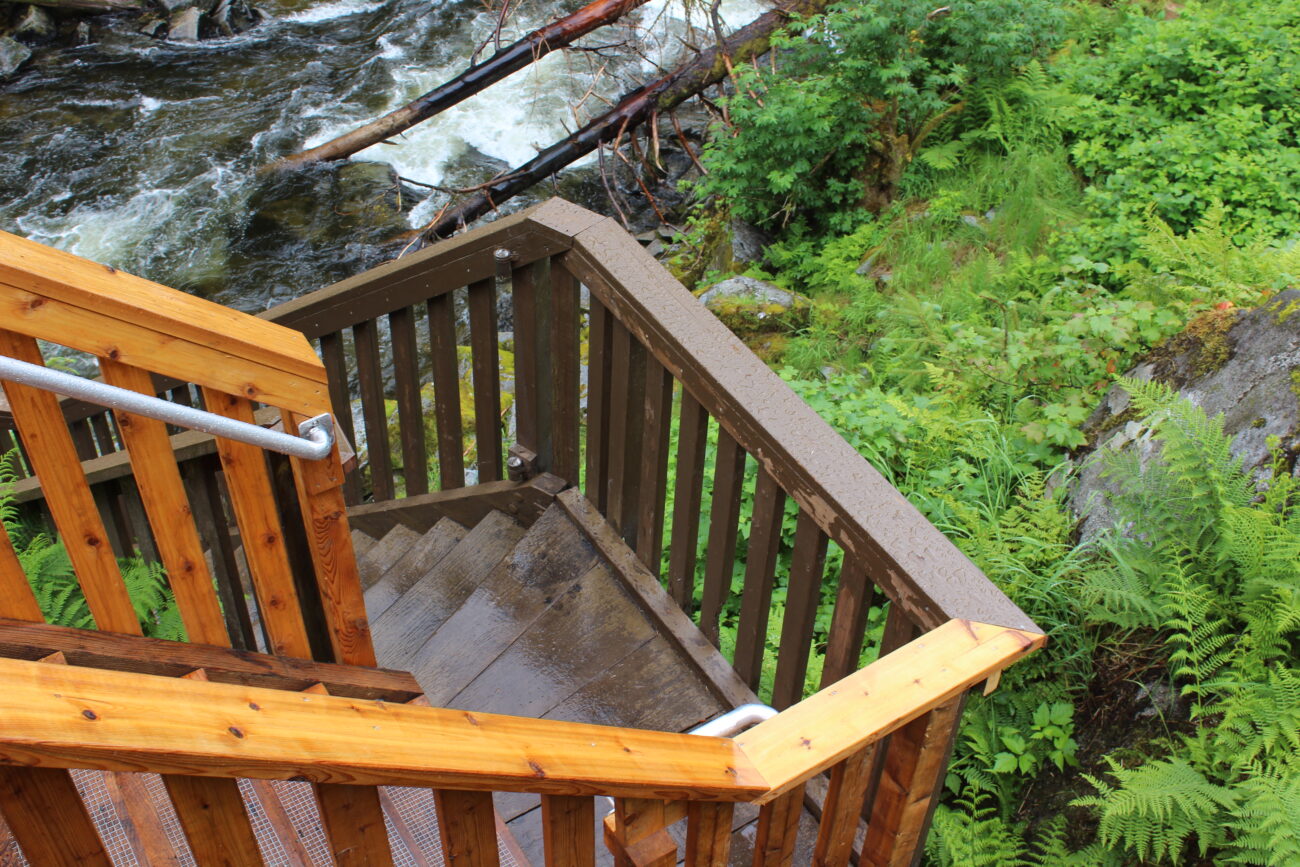
(Sage Smiley / KSTK)
Houser says the Wrangell Ranger District was lucky to be able to secure funding and have the process of replacing the deck move along relatively quickly. She attributes it to the growing popularity of the site, and a drive to bring as many people as possible to Anan without disrupting the wildlife.
“It’s about 60 people [per day] for 52 days,” Houser says. “That’s what we’re trying to do.”
Biological technician Kayleigh McCarthy says it’s hard to know the exact bear population around Anan, but she guesses there are around 30 black and brown bears. That’s a unique feature of the site; black and brown bears aren’t often spotted frequenting the same fishing holes.
“That’s not to say there’s only 30, but we keep a sheet of how many bears, how many individuals we see per day,” McCarthy says, “And I’ve had at least 30 a handful of times last season.”
Anan has been a popular wildlife-viewing site for a while, Houser says, even before viewing decks were present. While doing archaeology work required by the State Office of Historic Preservation, contractors found a quarter from 1943. It’ll be on display in a series of interpretive panels the Forest Service is working to put together about Anan history.
The deck-building process happened from March, when the snow cleared, through the beginning of June.
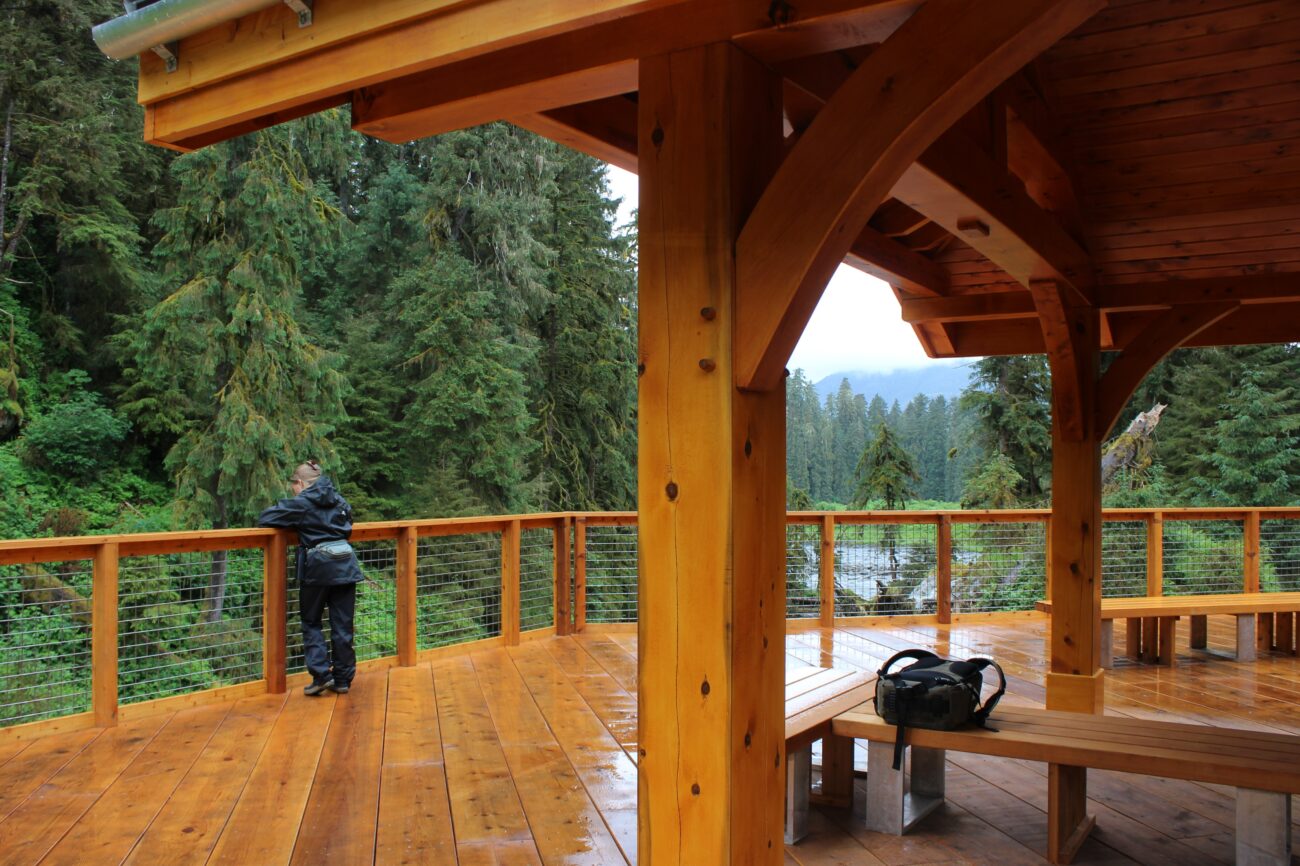
(Sage Smiley / KSTK)
“We really need[ed the project completed] for the livelihood of so many people in Wrangell, that was important to us,” Houser says. “We were like, ‘Contractors, you have to get this done, because these people are all depending on it.’”
McCarthy is one of the staff that rotate living at a floathouse in Anan Bay, monitoring bear activity, answering questions and giving safety talks to Anan visitors.
She says the new deck is a safer design, both for humans and for bears.
“The old deck had wooden planks as the railing, whereas this one has this metal braiding,” McCarthy explains. “Some people might be like: ‘Oh, it’s more industrial. But you can see through the metal squares a lot better than you can see through planks of wood, and one of the things we found ourselves telling a lot of people was, ‘Hey, don’t put your foot through the railing.’”
With the higher, single-level deck, McCarthy says she and her colleagues are interested to see how the bears’ utilization of the space below the deck might change.
“Will they just use it more as a passage because there’s more room and it’s less cave-like?” she asks, continuing: “But maybe they’ll like it better. We’ll see. I have a feeling there’s gonna be a lot of fish scraps under [the deck] by the end of the season. A lot.”
The deck replacement follows the revamping of the half-mile trail up to the viewing platform. Instead of boardwalk steps, the trail is now mostly gravel, Houser says.
“I think it’s going to be a lot more accessible for folks with varying walking abilities,” Houser says, “It’s way more level and easier to get around.”
Mostly replacing the old boardwalk trail with gravel cost just over $400,000, a project the Forest Service completed last fall.
“We were able to fund the trail through fee dollars, which is the fee money that outfitter and guides pay and your $10 fee for coming here,” Houser explains, “And that pooled with other fees from the Tongass – we were able to pay for the trail work.”
The deck was funded as a federal capital improvement project, clocking in at just under a million dollars ($999,000), Houser says. For the next phase of the project, the Wrangell Ranger District hopes to secure funding from the Great American Outdoors Act or other federal infrastructure funding programs.
“The next step is we would like to completely rebuild our lower platform,” Houser explains. “In our design, it’s slightly bigger. It has two stories and then the access is a spiral staircase that goes down from here (pointing to the edge of the deck above the current lower platform). That’s the idea. We have to put it out to bid and see if we can do it.”
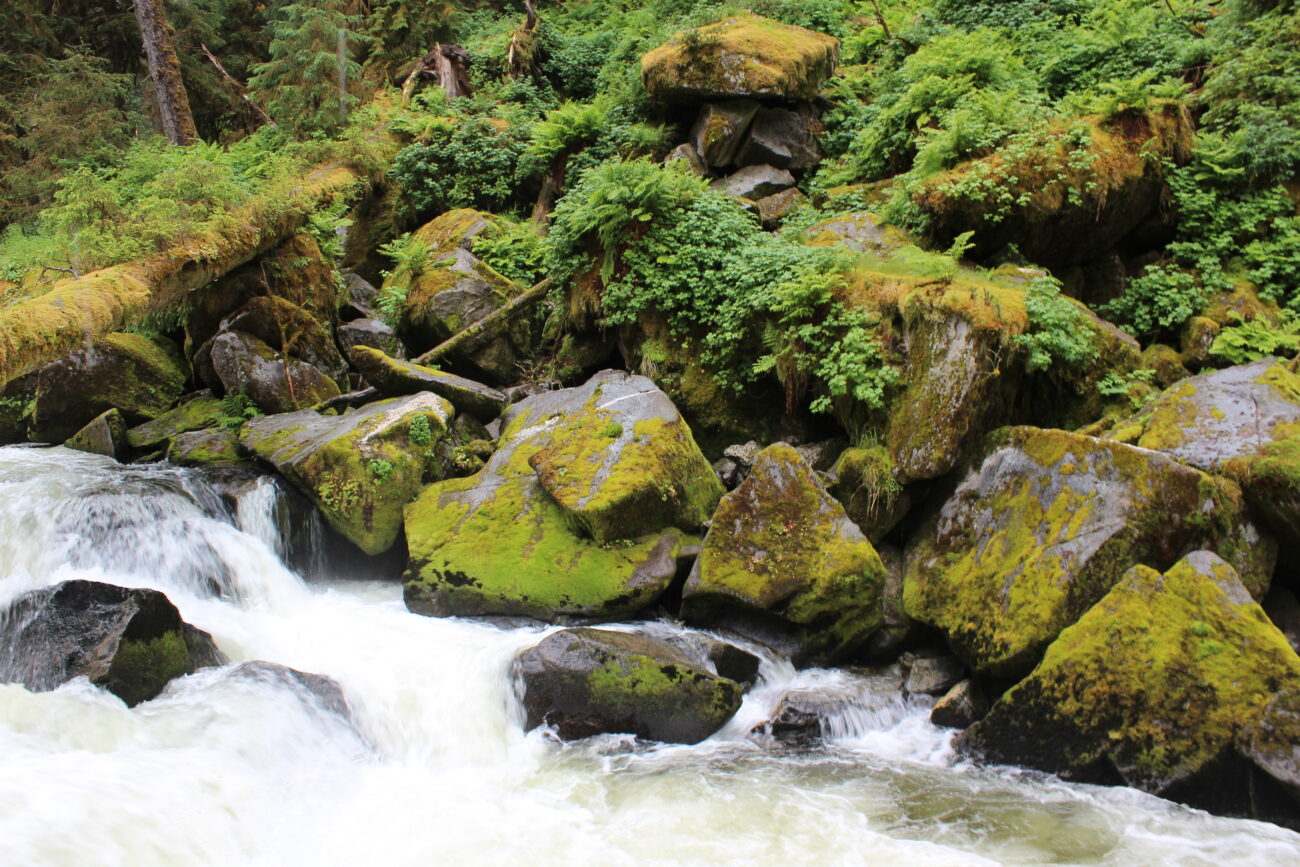
(Sage Smiley / KSTK)
The fish camera and cameras at the upper falls won’t be up and running this year; they’re part of that second phase of the project. But it’s a cool feature, Houser says: “There, you can see the fish swimming under and off. If you’re really lucky, you can see a bear swimming to catch fish underwater.”
In addition to a new trail and viewing deck, the Wrangell Ranger District is also working through applications to increase outfitter guide permits for Anan. In total, 22 outfitter guides applied for expanded permits.
“There were nine new ones, so quite a few folks, new folks trying to enter the game,” Houser says. “I think it’ll be a challenging decision to try to figure out how to distribute a very limited number – only 1,350, permits I think, and – people were able to put in their maximum and their minimum bids – for the maximum bid it was about 5,500 requests [for permits], and for the minimum, it was around 2,500. So it’s definitely going to be a hard decision.”
Wrangell District Ranger Clint Kolarich hasn’t made decisions yet about which outfitter guides will be allocated which permits, but those permits also won’t go into effect until next season.
On the late-June day KSTK visited the deck, there weren’t any salmon visible in Anan Creek, and no bears around. But they’re moving about, evidenced by a lot of olive-green bear scat.
Marc Lutz, editor of local paper the Wrangell Sentinel, is new to the bear-viewing experience.
“I can honestly say I have in person seen more bear scat than bears in my life now,” Lutz said after walking the trail.
While the deck and trail are ready to go, there is a major issue. It’s not just bears that need a place to do their doo.
“That’s not an official government sign,” Houser says with a laugh, gesturing to the bathroom at the base of the Anan trail, where visitors would get off tour boats. It’s plastered with lime green signs which read “OUT OF ORDER,” all-caps, with clipart of exploding volcanoes and steaming piles of poop.
“We are having complications with getting our toilet pumped,” she explains. “It is really, really challenging because we have to put a pumper truck onto a boat, a boat big enough to bring a big truck, then bring it up here on the high tide, with a hose big enough to empty these two 750-gallon tanks. We went through all the contracting that we had to do, [but] we are just having some real challenges with some of our government programs.”
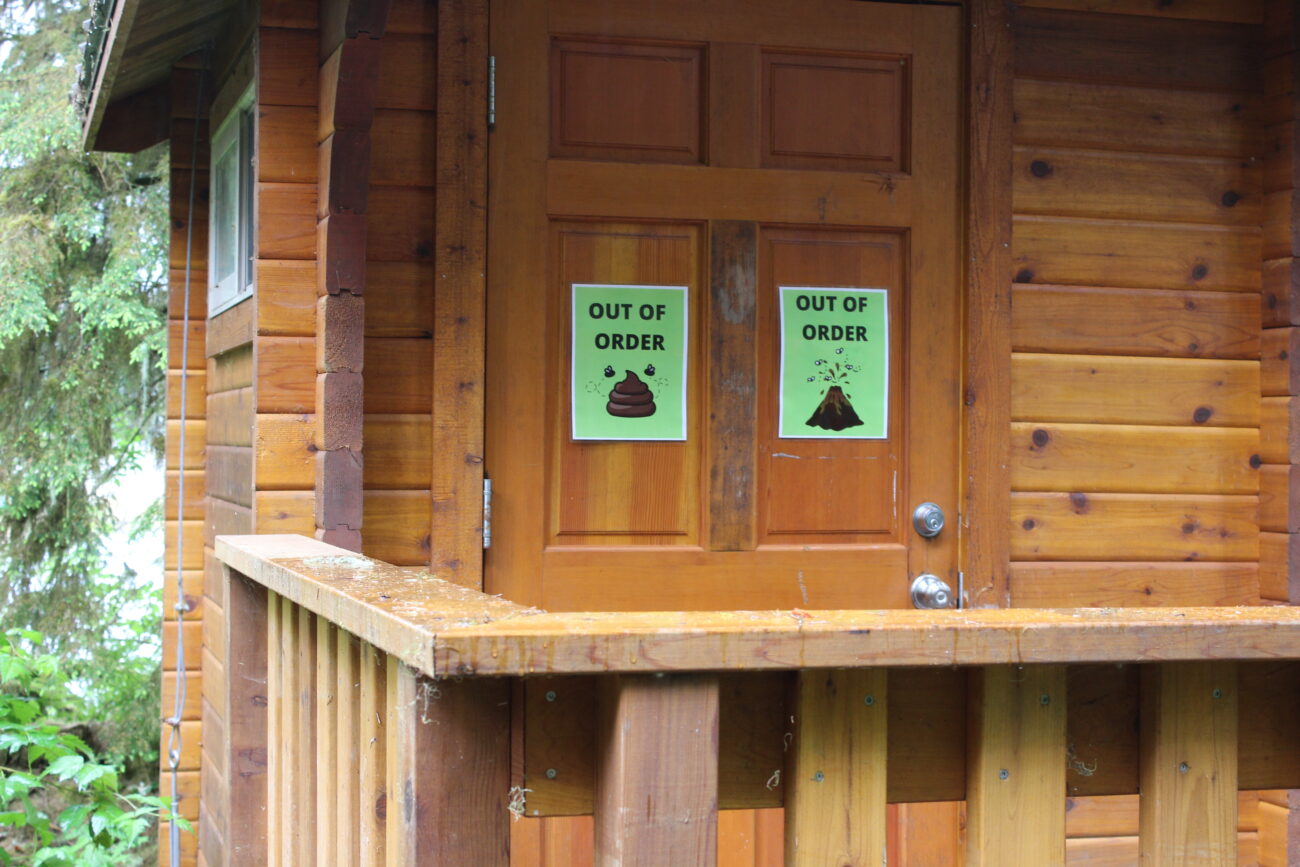
(Sage Smiley / KSTK)
Houser says that the holdup is with SAM.gov, the program contractors have to file through to receive federal funds. But the toilet desperately needs to be pumped.
“Because of COVID years and we had low numbers we didn’t pump it last year so now we’re really, I mean, REALLY full,” Houser explains.
And that could impact the visitor season, which officially opens just after the Fourth of July.
“That’s a potential consequence, because I don’t want to bring people off as cruise boats on a long boat ride – you guys were just on how long that boat ride is – and then have them arrive here and be like: ‘Oops, sorry,’” Houser says. She adds: “We have rules: policy says you can’t go off the trail here, so we can’t have folks going in the woods – for obvious reasons – to go to the bathroom.”
Once the tank is pumped, Houser says opening the new deck to visitors doesn’t mean the update process is over.
“This will be of course, small-scale ongoing improvement as people use it, they’ll let us know about little things,” Houser says: “‘Oh, you know, maybe you need backs on your benches for people to sit and lean against, or too much wind comes from the sides and maybe you can have a temporary panel,’ I mean, just who knows, but people will tell us and we can’t address everything people tell us but that’s we do try to do: make it better all the time.”
Anan’s viewing season begins July 5.
Get in touch with KSTK at news@kstk.org or (907) 874-2345.












